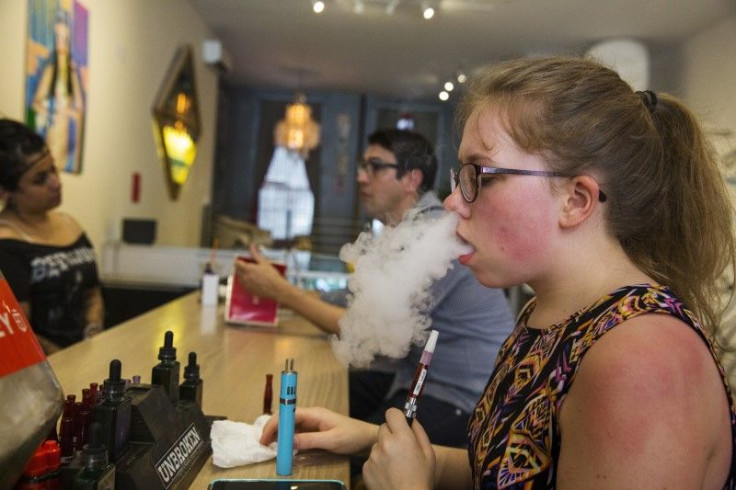FDA Cracks Down On E-Cigarettes And Cigars, Bans Sales To Minors

NEW YORK/WASHINGTON (Reuters) - The U.S. government on Thursday took wide-ranging steps to crack down for the first time on e-cigarettes and cigars, growing in popularity among teens, and banned sales to anyone under age 18 in hopes of sparing a new generation from nicotine addiction.
The Food and Drug Administration's action brought regulation of e-cigarettes, cigars, pipe tobacco and hookah tobacco in line with existing rules for cigarettes, smokeless tobacco and roll-your-own tobacco. The new rules take effect in 90 days.
The rules promise to have a major impact on the $3.4 billion e-cigarette industry that has flourished in the absence of federal regulation, making the nicotine-delivery devices the most commonly used tobacco products for U.S. youngsters.
The FDA said it will require companies to submit e-cigarettes and other newer tobacco products for government approval, provide it with a list of their ingredients and place health warnings on packages and in advertisements.
Health advocacy groups hailed the move. Industry officials said the regulations could hurt smaller companies and cripple a their job-creating business due to the expense of the regulatory process. Wall Street analysts expect the regulations to herald a new wave of consolidation led by big tobacco companies.
E-cigarettes are handheld electronic devices that vaporize a fluid typically including nicotine and a flavor component. Using them is called "vaping."
The FDA will require age verification by photo identification, ban sales from vending machines except in adults-only locations and stop the distribution of free product samples.
The new regulations had been highly anticipated after the agency issued a proposed rule two years ago on how to oversee the e-cigarette industry and the other products.
"Millions of kids are being introduced to nicotine every year, a new generation hooked on a highly addictive chemical," U.S. Secretary of Health and Human Services Sylvia Burwell told reporters, calling the rules a first step toward breaking the cycle of addiction.
Burwell said health officials still do not have the scientific evidence showing e-cigarettes can help smokers quit, as the industry asserts, and avoid the known ills of tobacco.
The e-cigarette vapor industry, which includes e-cigarettes, vapors, personal vaporizers and tanks, is expected to have about $4.1 billion in sales in 2016, Wells Fargo estimated in a recent research note.
"These new regulations create an enormously cost-prohibitive regulatory process for manufacturers to market their products to adult smokers and vapers," said Cynthia Cabrera, president of the Smoke-Free Alternatives Trade Association, representing the e-cigarette industry.
Three million U.S. middle and high school students reported using e-cigarettes in 2015, compared with 2.46 million in 2014, according to the most recent federal data.
A University of Southern California study of high school students last year found that those who used e-cigarettes were more than twice as likely to also smoke traditional cigarettes. While some researchers believe e-cigarettes pose lower cancer risk because they do not burn tobacco, other researchers view e-cigarette vapor as potentially harmful because of chemicals released during the burning process.
"This is a real epidemic and banning the sales of these products to minors, much like cigarettes, is a critical step to protecting their health now and into the future," said Democratic U.S. Representative Lois Capps of California.
Reynolds American Inc
Altria, which makes Marlboro cigarettes and e-cigarettes, said it was concerned the regulations reached back to 2007 to determine which products to review, spokesman David Sutton said. Reynolds, which sells Newport and traditional cigarettes as well as Vuse e-cigarettes, will discuss with the FDA how to establish a reasonable structure for review and approval, spokesman David Howard said.
CONTROVERSY OVER FLAVORS
Public health advocates also have urged the FDA to ban the use of flavored nicotine liquid in e-cigarette and personal vaporizers. They contend the flavors, which can range from bacon to bubble gum, lure youngsters into taking up vaping.
FDA officials said they would consider future regulation on flavors based on further study of vaping's potential risks and benefits. The FDA did ban flavors in cigars.
The agency said as more scientific data emerges on potential dangers from e-cigarette vapor, it will consider restricting advertising of the products.
In 2009, Congress allowed the FDA to extend its oversight to all tobacco products. The agency began looking at e-cigarettes, which were quickly gaining traction in the U.S. market.
Cigars had previously not been regulated by the FDA. Cigar makers had lobbied for their more expensive, typically hand-rolled products to be excluded from such oversight.
The FDA will review products introduced after Feb. 15, 2007, but will give manufacturers of e-cigarettes and these other products up to two years to submit applications. E-cigarette makers can continue to sell those products while the review is pending.
Agency officials expect that most products on the market will require its review, a costly prospect for the many smaller manufacturers of vaping devices.
"The winners are the large tobacco manufacturers, primarily Altria
The cigar market is expected to grow to more than $8.9 billion in 2019, up from $7.4 billion in 2009, according to Euromonitor. It is dominated by Swisher International, Altria and Imperial, which combined in 2014 sold about half of the cigars in the United States, according to Euromonitor.
Companies will be allowed to continue marketing their products while the FDA conducts its reviews, which could take 12 months after submission.
(Reporting by Caroline Humer, Jilian Mincer and Bill Berkrot in New York and Clarece Polke and Toni Clarke in Washington; Editing by Michele Gershberg and Will Dunham)
Published by Medicaldaily.com



























